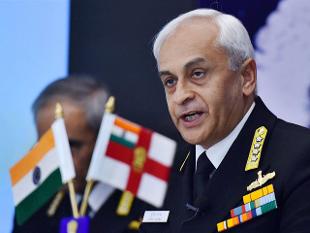New Delhi, Dec 3: The Indian Navy on Friday said it was aware of the deployment and movement of Chinese naval ships and submarines in the Indian Ocean Region, and that it has “kept a close eye” on them.
 Addressing the annual ‘Naval Day' news conference in New Delhi, Navy chief Sunil Lanba said a Chinese nuclear submarine was deployed in the Indian Ocean and it made a port call at Karachi harbour. “As far as People's Liberation Army (PLA) Navy ships and submarines are concerned, the Indian Navy keeps a close eye and monitors their movements. We have maritime domain awareness of the deployment of PLA naval forces in the Indian Ocean Region (IOR).
Addressing the annual ‘Naval Day' news conference in New Delhi, Navy chief Sunil Lanba said a Chinese nuclear submarine was deployed in the Indian Ocean and it made a port call at Karachi harbour. “As far as People's Liberation Army (PLA) Navy ships and submarines are concerned, the Indian Navy keeps a close eye and monitors their movements. We have maritime domain awareness of the deployment of PLA naval forces in the Indian Ocean Region (IOR).
“We launch surveillance missions in the form of aircraft and ships to keep a track of them. They had started deployment of their submarines from 2012,” he said.
The Chief of Naval Staff said India's primary area of interest was the IOR followed by Strait of Bab el Mandeb and the Strait of Hormuz.
In response to a question on Indian Navy's capabilities in the Pacific region, Lanba said, “The Navy is well within its capabilities to operate in the region.” Lanba also sought to downplay the Bangladesh Navy acquiring its first submarines from China, saying “India has a plan in place that takes into account what is happening in the neighborhood.”
When asked about the South China Sea dispute, the Navy chief said maritime issues should be solved as per United Nations Convention on the Law of the Sea (UNCLOS). He added that the Kalavari Class Scorpene submarine will be commissioned next year.
In Mumbai, Vice Admiral Girish Luthra, Flag Officer Commanding in Chief (FOC-in-C) of the Western Naval Command said the Indian Navy was working on improving physical security of all its bases and assets not just in Maharashtra but in the entire west coast. The Indian Navy, he said, was introducing new technologies for perimeter security and was also increasing patrolling and surveillance and strengthening the response mechanism in case of breaches. Security audits have also been conducted to “observe shortcomings.”
As per its perspective measure, the Indian Navy plans to build next-generation destroyers with a new design which will be more potent and versatile, said Luthra.
He said that INS Kalavari, the first of its six Scorpene class submarines, would be commissioned soon into the Indian Navy. The Navy's six Scorpene-class stealth submarines are being constructed under the much-delayed Project-75 at the Mazagon Dock Shipbuilders Limited (MDL) in collaboration with DCNS, France to augment its depleted and aging underwater fleet.
‘PAK CLAIM BOGUS'
Indian Navy chief Admiral Sunil Lanba on Friday termed the claims made by Pakistan that an Indian submarine had entered into territorial waters, as “bogus”. “There was no Indian submarine deployed in the area where the Pakistani Navy is claiming it to be. As far as repelling a submarine of any nation goes, it is not an easy task and the claim made by Pakistani Navy is totally bogus. We deploy submarines where there is an operational necessity and we will continue to deploy them,” the Navy chief Admiral Sunil Lanba said.





Comments
Add new comment